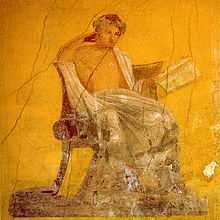House of Menander

The House of Menander is a building in Pompeii, Italy. It is located in the southern half of the town, just northeast of the Little and Large Theaters, as well as the Gladiators’ barracks.The House of the Menander was almost as big as a whole city block[1] An unknown architect constructed it in the late 1st century BC.
Speculations about the owner
The name of the owner of the House of Menander is Quintus Poppeus, but due to the villa’s impressive size and intricate structure, as well as the numerous decorative touches such as frescoes, it has been concluded that a well-to-do merchant owned the house when Vesuvius erupted. This view is also supported by the house’s location near the center of town, only two blocks from the lavish Stabian Baths. Use of this bath-house, a public washhouse and brothel with walls covered in erotic art, was thought of as a sign of luxury.[1][2]
The nationality of the owner is more in dispute than his economic status. Pompeii’s Mediterranean climate enticed many Romans to invest in holiday villas there, so it is possible that the owner at the time of Vesuvius’ eruption was a wealthy tourist, not a local.[1]
Art, architecture, and relics
Fresco
The estate is referred to as “The House of Menander” because there is a well-preserved fresco of the ancient Greek Dramatist Menander in a niche in the peristyle. The fresco is now commonly referred to as “Painting of the Poet,” and has bold yellow and red coloring, a sign of wealth. The colors, coupled with a background that lacks either linear or implied perspective, place the fresco firmly in the First of the Pompeian Fresco Styles that the German archaeologist August Mau discerned while excavating Pompeii.[2] Some speculate the painting is not actually of Menander but rather of the owner of the house or another person reading works by Menander.
The house included other frescoes, including one depicting the death of Laocoon.
Menander
Menander was known for often employing maxims to sum up the most practical way to live.[3] His tradition, if not his image, is further displayed by the wit of two local merchants, Sirico and Nummianus, who had the phrase “Salve, lucru” (Welcome, money) inscribed in their atrium.[1]
Classical style and Hellenism
The large columns in the peristyle at the House of Menander are representative of the Doric style of architecture, an offshoot of the Classical Style, which also stems from Greece. The emphasis on Greek culture in Pompeian architecture is not surprising since Greek sailors had been using the port as a trading post before the Oscans founded the city in the 6th century BC.[2][4]
Pompeian economy
A focus on simplicity and effectiveness allowed the Pompeian merchants to develop “a full range of commerce and industry” before Vesuvius destroyed the town in 79 AD. Evidence of this economy’s diversity includes two meter high stone mills, proof much cooking was done; large ceramic tanks for dyeing or laundering clothes and storing wine; as well as hammers and chisels left by metalworkers and jewelry makers, proof that at least some Pompeians had expendable income.[5]
References
| Wikimedia Commons has media related to Casa del Menandro (Pompeii). |
- ↑ 1.0 1.1 1.2 1.3 No Author Listed, House of Menander, Tourist Attractions in Pompeii, Italy 2007
- ↑ 2.0 2.1 2.2 Roberts, Adam, Classical Architecture. London, Penguin Books. 1990
- ↑ Menander, Encyclopædia Britannica, Encyclopædia Britannica Online
- ↑ Curran, Leo, Pompeii: House of Pansa: Atrium and Peristyle, 1988
- ↑ Jones, Rick, Interactive Dig Pompeii, Archaeology Magazine, 2001
Coordinates: 40°44′59″N 14°29′24″E / 40.74972°N 14.49000°E
| ||||||||||||||||||||||||||||||||||||||